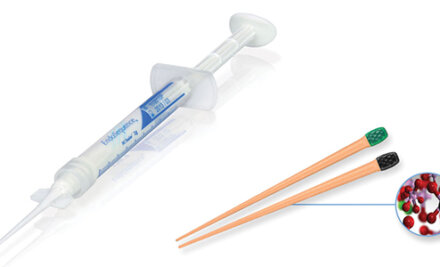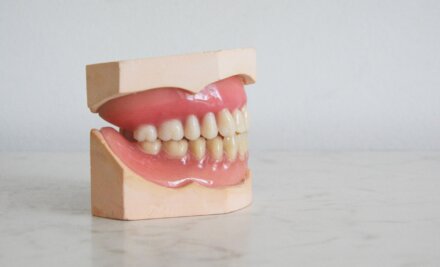Integrative Endodontics uses state-of-the-art techniques to help your teeth regenerate damaged structures in the treatment of deep cavities. As teeth heal, the roots and nerves function optimally again so your natural teeth and smile can be saved.
Among natural alternatives to root canal treatment, we have found that regenerative endodontics and vital pulp therapy (VPT) are a promising route. Regenerative techniques are not always an alternative to root canal therapy (RCT), yet they can be in some cases, when the diagnosis is still in a reversible stage of inflammation.
To revitalize the tooth, our doctors perform many indirect pulp caps, which can treat deep cavities and preserve the pulp, which contains the tooth’s nerves and blood vessels. This treatment stimulates a process called dentinogenesis, in which the tooth begins to heal itself. It can grow new tooth structure over the affected area, which may have been injured.
As part of our regenerative endodontic services, we provide the following:
Indirect pulp caps
Direct pulp caps
Pulpotomy
Apexogenesis
Apexification
Revascularization
To treat these deep cavities, we use VPT in conjunction with laser and ozone therapy inside the tooth. We call this signature process EndOzLase™, and we use it in both our VPT and RCT processes. In VPT, the laser gently removes deeper decay, preserving the integrity of the pulp and disinfecting the dentin. The subsequent ozone treatment opens and disinfects the dentinal tubules, allowing further penetration of the biocompatible materials, which are designed to support the tooth’s remineralization process.
A 14-year-old boy came into Integrative Endodontics with a large cavity in his lower-right molar. He had no history of symptoms, which is ideal for successful vital pulp therapy (VPT).
The initial radiograph (X-ray image) shows the decay. You can also see slight swelling in the periodontal ligament, which is located at the tip of the root.
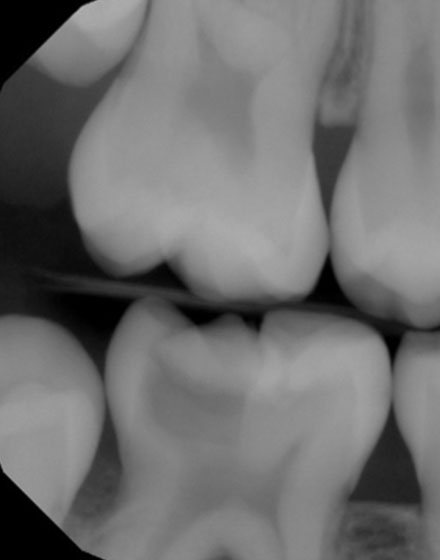
14 year old with decay extending into the pulp.
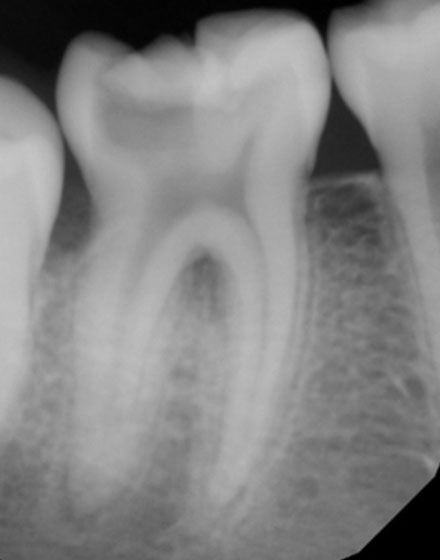
Minor swelling in the Periodontal Ligament shows Inflammation has reached the radicular pulp and surrounding tissues.
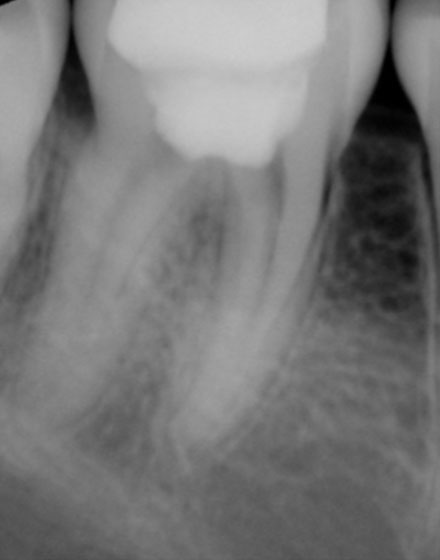
A 6-month recall after EndOzlase pulpotomy performed showed regeneration of the Periodontal Ligament.
After isolating the tooth to avoid contamination, the laser was used to remove the decay and bacteria trapped in the dentinal tubules. In this case, the bacterial infiltration had already created irreversible damage to the coronal pulp.
A pulpotomy procedure was performed with the laser to selectively remove the inflamed tissue. Once healthy tissue was identified, gentle ozone therapy1 was performed to stimulate the microcirculation of blood within the pulp.
Next, a biocompatible material was placed, which facilitates a mineralized barrier formation at the interface with the pulp tissue. The osteoinductive properties of bioceramics help to create a framework for new dentin formation, as well as preventing bacterial adherence.
1 Shilpa, Reddy A et al. “Role of Ozone Therapy in Minimal Intervention Dentistry and Endodontics – A Review.” Published online 2013 Jun 23. Accessed 2021 Mar 8. https://www.ncbi.nlm.nih.gov/pmc/articles/PMC3769872/
To monitor progress and healing, we asked the patient to return for new radiography. This recall image shows the periodontal ligament regenerated, returning to its normal shape and size at the apex of the root.
“My family and I have nothing but amazing things to say about Dr. Kanter. As the father of 7 children and a lifelong believer in the power of holistic medicine, I was terrified at the idea of my youngest son needing a root canal. I was told that there may not be any other options to save his tooth, as the decay had begun to enter his gums. I was then advised by LA holistic Dentistry to speak with Dr. Kanter. Dr. Kanter took the time to sit with me and discuss, in detail, possible alternatives to a root canal. She mentioned a novel procedure called a pulp cap/vital pulp therapy. She made sure to explain all of the steps of the procedure and I felt nothing but confident in agreeing to let her do one on my son’s tooth.The results were amazing and not only did she save my son from having to get a root canal, he is also completely free of any pain. Thank you so much, Dr. Kanter for being such an incredible dentist and person.”
– Andy Lodi
Read Dr. Val’s insights on Platelet-Rich Fibrin.
REGENERATIVE ENDODONTICS
FAQs
In traditional root canal treatments, the pulp (the living part of the tooth) is completely removed. Vital pulp therapy – also known as VPT – selectively treats injured or inflamed tooth pulp, with the intention of keeping it alive.
Generally this involves removing the damaged part of the pulp – and protecting the remaining pulp from further trauma – in order to stimulate the growth of new, healthy tooth structures.
If a deep cavity has reached the nerve – and that nerve is irreversibly inflamed and exposed – then integrative root canal therapy is often the best option.
Depending on the state of the nerve and inflammation, a patient may be a candidate for VPT. Under the umbrella of VPT, you find both indirect and direct pulp cap procedures performed with EndOzLase™:
If pulp exposure can be avoided during deep caries removal (aka removal of a deep cavity) an indirect pulp cap with the EndOzLase treatment can be performed to help maintain the tooth’s vitality. This regenerative approach, designed by Dr. Valerie Kanter, involves a series of technique-sensitive steps and uses multiple integrative therapies.
Even if the nerve is exposed yet not overtly inflamed, the EndOzLase system can often be used to safely perform a direct pulp cap. This initiates a reparative process in which new dentin grows to create a hard tissue barrier to protect the underlying pulp. Since each person’s body is unique, their pulp’s reactions to dental materials are too. Our office carefully chooses biologically appropriate materials, and we offer laboratory testing before treatments. With these insights, we can make better decisions about what materials to use from patient to patient.
For patients with a diagnosis that indicates VPT is an appropriate route, this is a root canal alternative that is natural and a key part of the new, integrative paradigm we have adopted as Integrative Endodontics.
PRF stands for Platelet-Rich Fibrin, a substance created from a patient’s own blood platelets, right in the Integrative Endodontics office. A very small amount of blood is drawn from the patient and placed into a centrifuge, which separates red blood cells, white blood cells, and platelets. A gel-like membrane is created from the platelets and white blood cells, and this matrix continues to release growth factors that stimulate tissue regeneration. This membrane is applied to the area that needs to heal.
PRF triggers natural regenerative processes and may be used in many types of dental procedures. You may find PRF used in direct pulp caps on adults and children, as well as all other regenerative procedures for children, such as a pulpotomy. Pulpotomy procedures are most often performed on younger individuals and are designed for mild nerve degeneration that is asymptomatic (i.e., no pain). Evaluating whether to perform a pulpotomy depends on the endodontist’s operative process and actually seeing the health of the radicular nerve.
For children who are facing dental-health challenges early on, pulpotomy procedures and revascularization are steps to consider, both of which fall under the umbrella of “regenerative endodontics.” Pulpotomy is considered a part of VPT because only the inflamed part of the pulp is removed, still leaving vital tissues within the root, in an attempt to preserve them and create a healthy environment inside and outside the tooth.
Revascularization is a very different regenerative procedure. In revascularization, a young tooth has already died, and the procedure helps by removing the necrotic tissues and stimulating new, healthy structures to grow back inside the root.
So far, regenerative endodontic therapies have been used most widely with children, because the roots and tissues of their teeth are still growing and developing, making them easier to bring back to life. This new frontier of research is exploring the use of similar techniques on adult teeth, bringing nerves and other tissues back to life using innovative technologies, such as lasers and other regenerative treatments. Most adults can undergo successful treatment for indirect or direct pulp caps, which are a subset of vital pulp therapy (VPT).
Whether the patient is a child or an adult, we usually use VPT to treat teeth with cavities, rather than teeth that already have fillings or crowns.
For adults, the most common VPT treatment is indirect pulp caps, followed by direct pulp caps, and then pulpotomies. If you are an adult seeking regenerative endodontic treatment, it’s critical to understand that inflammation of adult teeth is more likely to become irreversible, compared to children’s teeth. This is due to the nature of a tooth’s aging process, which includes a lack of collateral circulation.
If VPT is an option for you, as an adult, you can increase your chance of success:
- Adjust your diet to decrease your systemic inflammation.
- Minimize exposure to environmental toxins.
- Get regular exercise, sleep, and meditation.
- Gain insights for your practitioner with laboratory testing. We find OralDNA to be a very valuable tool.
- Ask your practitioner for supplements appropriate to your health situation. We supply every patient with suggested supplementation to support their immune system, healing process, and more.
Yes, it’s possible that we can utilize regenerative techniques to revive and restore the tooth.
If children suffer from trauma to a tooth during sports or play, it is very important to bring them to see our doctors as soon as possible (less than 24 hours), so they can ensure that the tooth is repaired on the inside, as well as the outside.
Be sure to act quickly, as prompt action can prevent the death of the tooth, infection, and eventually, the need for more extensive repair or removal. Call us for emergency dental care with a balance approach →
Resources: Regenerative Endodontic Therapy: The Fountain of Youth for a Dying Tooth, Dr. Valerie Kanter, IABDM; and Fillings That Heal Your Teeth, The University of Nottingham.


